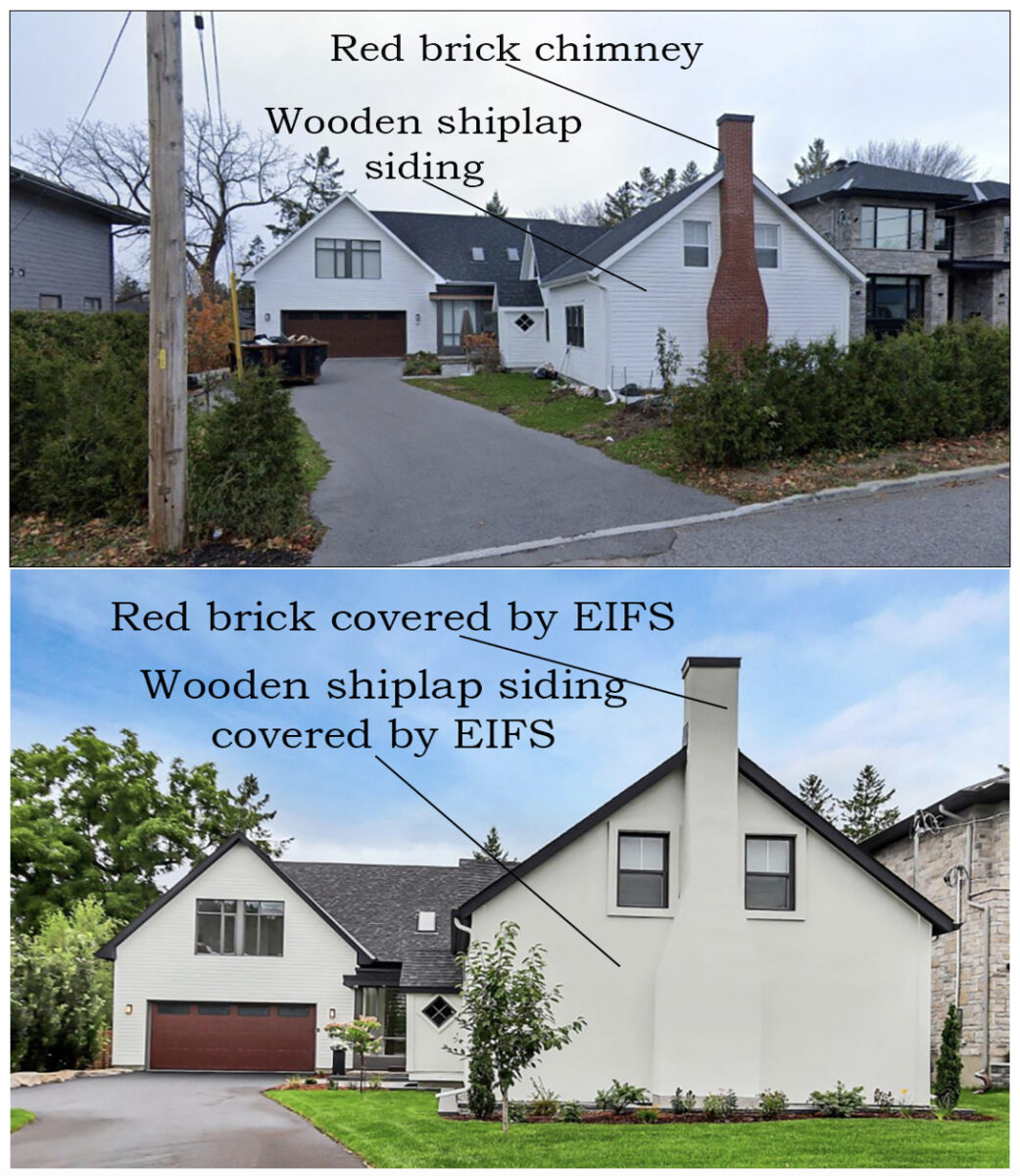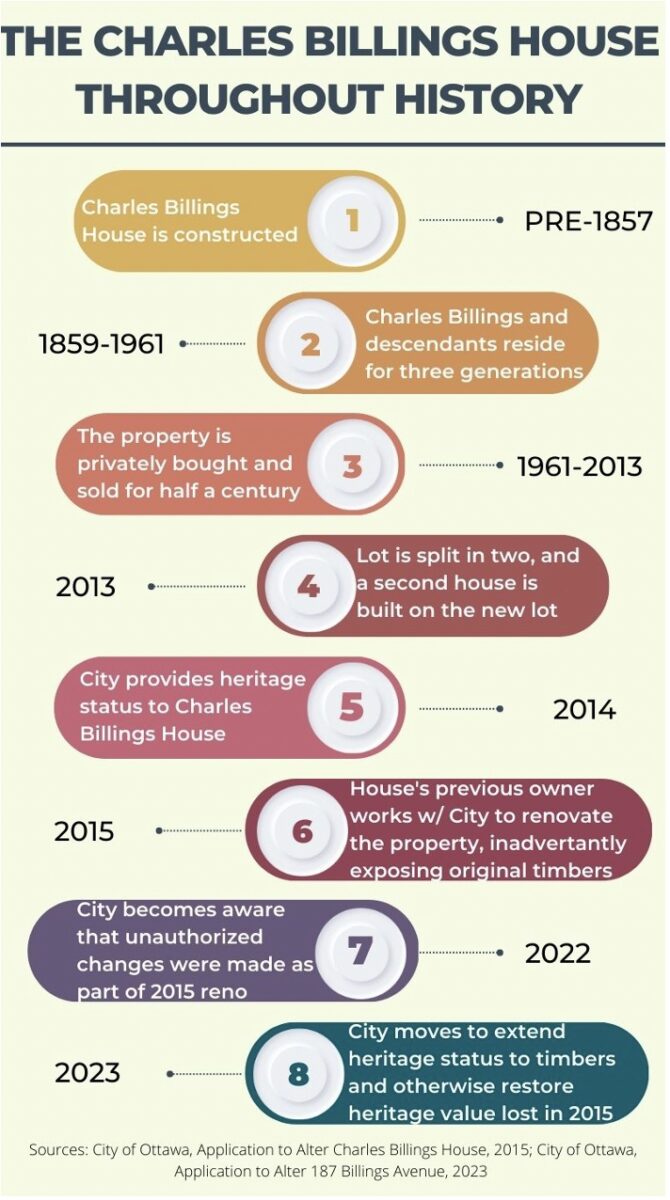In 2015, unauthorized changes were made to one of the oldest homes in Ottawa. According to a new decision from the city, this may have turned out to be a happy accident.
The historic Charles Billings House, located in the Alta Vista neighbourhood, dates back to the settler period of Ottawa’s pre-Confederation days. The building’s 2014 designation under the Ontario Heritage Act cited its original red brick chimneys, wooden “shiplap” siding and singular diamond-shaped window as elements of historical value.
These were defining characteristics of home architecture style when the building was constructed some time between 1830 and 1857.


“There aren’t too many buildings left from that vintage,” said Ashley Kotarba, a City of Ottawa heritage planner.
But when an unauthorized 2015 renovation to the home removed some drywall the year after the heritage designation was made, the homeowner — and soon after the city — found something else: hand-hewn timbers lining the interior walls of the home, dating back to the building’s original construction.
“We don’t know how long they were drywalled over,” Kotarba explained. “I suspect it was probably decades.”
Last week, the city approved a unanimous recommendation from the Built Heritage Committee to retroactively approve the 2015 changes while extending the heritage designation to the uncovered timbers. The committee’s recommendation also included measures to restore other heritage attributes altered in 2015.


Elements including the home’s gabled roof, entrance vestibule and unorthodox orientation away from the street and towards the river are all representative of the Ontario Cottage Style, the most popular type of home in the province at the time of construction. A statement of heritage value prepared by city officials describes the “rugged” house as “historically valuable” for its early association with the Billings family as they developed and leased land in the area in the early 19th century, noting also that Ontario Cottage Style homes were “principally built for shelter” as opposed to “aesthetic value.”
Houses like this are some of the few tangible connections to that early history of the settlement period that remain in the city.
“(Charles Billings) lived there for many generations, so that’s one of the early houses in (former) Gloucester township,” Kotarba explained. “It helps to tell us the early history of settlers of Gloucester in terms of architecture, and just the history of development patterns.”
Members of the Billings family were among the earliest settlers of the Ottawa Valley. Their significance in local history is reflected by the Billings Estate Museum and National Historic Site, a City of Ottawa-owned heritage centre that preserves the family’s original main residence not far from the Charles Billings House in Alta Vista.
The Ottawa village traditionally known as Billings Bridge and now part of Alta Vista is also recalled in the name of the Rideau River crossing at Bank Street and Riverside Drive and at the adjacent Billings Bridge Shopping Centre.
Designation under the Heritage Act is meant to ensure that the historic elements of these properties will always be preserved, repaired or, in some cases, replaced in accordance with their original aesthetic and materials. The uncovered timbers in the Charles Billings House, Carolyn Quinn of Heritage Ottawa explains, are significant enough to receive these same protections.


“They reveal an important example of early 19th-century construction materials and methods of which few examples remain in the city,” she said. “Heritage status will help ensure their preservation into the future.”
The city’s built heritage sub-committee’s recommendation included some other measures to restore the heritage value of the house. The 2015 renovation also made changes to the building’s exterior, covering the wooden shiplap siding and one of the red brick chimneys with an Exterior Insulation Finish System, or EIFS.
The city now plans to remove the EIFS insulation from the chimney and add new siding that replicates the home’s original look.
The relatively new discovery of this previously unknown historic attribute raises further questions about what could be lying behind the drywall in other heritage properties. Although many of these properties are private residences today, Kotarba explains that it could be “worthwhile and interesting” to look back at some heritage designations dating back to the early 1980s.
“We don’t have much information on them because they were done at a time when the (heritage) designation wasn’t as rigorous,” she said. “Now we go into much more detail, and it would be really interesting to revisit some of those and see if there’s new attributes that we didn’t know about at the time, like this example here.”



![Artifacts at the Order of Sports Collection at the Museum of History in Ottawa on Nov.17, 2023 [Photo taken by Jayden Dill].](https://capitalcurrent.ca/wp-content/uploads/2023/11/Featured-Image-250x141.jpg)
